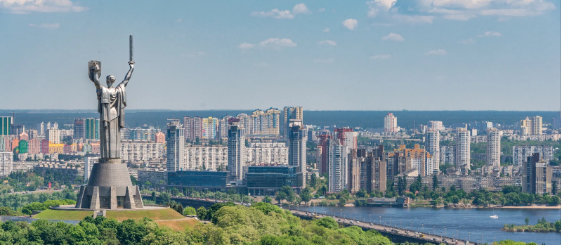
Innumerable factors could go wrong, but our base case foresees solid reconstruction and recovery
Planning for the long-term outlook for Ukraine is extraordinarily difficult at the current moment in light of the infinite variables involved, demanding scenario planning and ascribing likelihoods as well as corporate investment interest to each long-term scenario. Taking into account our base-case expectation, firms should plan for a weaker hryvnia to the US$—likely averaging around 40 for the coming years—and inflation to only moderate to below 10% starting in 2025, bringing down currently very high interest rates with it. Assuming an end to Russian strikes on central/western Ukraine, foreign and domestic investment will accelerate dramatically, underpinning real income growth and purchasing power over time.
Overview
- Estimates suggest that Ukraine to date requires up to US$ 800 billion for long-term reconstruction, and with fighting expected to continue for at least the rest of this year, consensus estimates on the longer-term costs approach US$ 1 trillion.
- The US and the European Commission, with the backing of a UN vote on the matter late in 2022, have publicly affirmed their intention to find the legal avenue for confiscating Russia’s FX reserves (amounting to ~US$ 300 billion) and transfer them to Ukraine.
- The US, EU, International Monetary Fund, and other Western donors have included in their budgets promises that will cover Ukraine’s budget expenses as well as additional humanitarian and reconstruction costs for 2023.
Our View
First and foremost, any discussions on investing in Ukraine revolve around the need to achieve a more stable line of contact in the war, thus allowing for sustained peace in at least a majority of the country in the next couple of years, as our base-case scenario anticipates. In addition, not only will Ukraine require continued solid defense and financial support from the West in 2023, but also for the longer term, which involves the need for Russia’s reserves to serve as the foundation for the monumental cost of reconstruction. Beyond those factors, the timing and nature of a ceasefire deal, the government of Ukraine’s adherence to rule of law and anti-corruption policies, and the return of Ukrainian refugees abroad will be determinant for Ukraine’s long-term economic recovery after the war. As our base-case expectations view these factors as generally positive for Ukraine, we remain moderately optimistic for Ukraine’s solid reconstruction, and therefore solid investment and demand recovery in the years ahead.
As it pertains to the war, in the most likely scenario, the war of attrition is set to continue for the long term following this current major uptick in fighting in H1, as neither side will be able to fundamentally win the war. At that point, with both sides largely exhausted, considerable pressure for ceasefire talks will rise as the line of contact will have mostly stabilized with no significant prospect for moving notably over the short, medium, and longer terms.
Over time, akin to the demilitarized zone (DMZ) in Korea established from the armistice in 1953 or the Berlin Wall established following the Berlin Crisis of 1961, a settlement will be negotiated that establishes a border between the two sides. Critically for the development of rump Ukraine west of this contact line, in this negotiated settlement there will have to be provisions for Western security guarantees (quasi-NATO status) as well as promises by the Russian side to end the missile barrages of rump Ukraine west of the border.
As with Ukraine’s defense, the entire country and its future are reliant on continued Western political and financial support, which could come under pressure, and in particular from Republicans in the US, by late 2024. To date, transatlantic unity and support for Ukraine have been at their highest points since the end of the Cold War and are expected to remain so in 2023 in light of the continued threat posed by Russia (and China) to the Western world. US domestic politics, evolutions on the battlefield, high energy costs, ceasefire overtures from the Kremlin, or otherwise an unexpected black swan event could all undermine this re-found Western unity and support for Ukraine over time, however, threatening Ukraine’s outlook.
Worryingly, there remain the issues of funding this US$ 1 trillion in reconstruction costs, Ukraine’s long-term structural problems related to corruption, and the loss of an estimated 5 million Ukrainians still abroad since the war began. Should the West fail to find the legal route to transfer Russia’s sanctioned US$ 300+ billion held in Western banks to Ukraine (sanctioned the weekend of the invasion), there would likely be inadequate Western government and private investor support to fill the remaining hole. In addition, proper use of these funds will be under intense scrutiny given Ukraine’s track record for corruption.
Positively, considering this national trauma of the war, there will be major domestic political and social pressure to become a Western, rule-of-law society, anchored by reform pressure in seeking accession to the EU by the end of the decade. Meanwhile, having seen millions flee abroad following the invasion, the majority have already returned out of a sense of national solidarity and pride. In addition, with an estimated 5 million Ukrainians still abroad in the EU, it is expected that at least half would return, given the high cost of living abroad, aiding reconstruction and the economic recovery.
At FrontierView, our mission is to help our clients grow and win in their most important markets. We are excited to share that FiscalNote, a leading technology provider of global policy and market intelligence has acquired FrontierView. We will continue to cover issues and topics driving growth in your business, while fully leveraging FiscalNote’s portfolio within the global risk, ESG, and geopolitical advisory product suite.
Subscribe to our weekly newsletter The Lens published by our Global Economics and Scenarios team which highlights high-impact developments and trends for business professionals. For full access to our offerings, start your free trial today and download our complimentary mobile app, available on iOS and Android.

